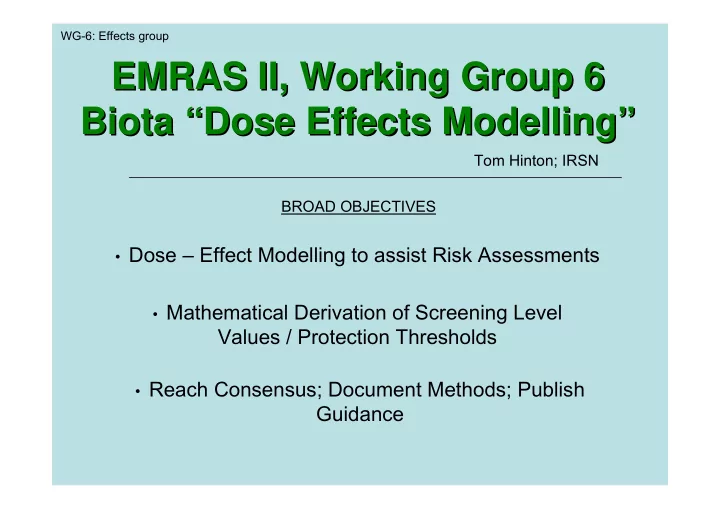

WG-6: Effects group EMRAS II, Working Group 6 EMRAS II, Working Group 6 Biota “ “Dose Effects Modelling Dose Effects Modelling” ” Biota Tom Hinton; IRSN BROAD OBJECTIVES • Dose – Effect Modelling to assist Risk Assessments • Mathematical Derivation of Screening Level Values / Protection Thresholds • Reach Consensus; Document Methods; Publish Guidance
WG-6: Effects group First Year Progress Report 1) UPDATE Dose-Effect DATABASE ( Almudena Real ; Spain) ( UNSCEAR; post 2006; Russian/Ukrainian ) D. Copplestone, S. Geras ´ kin, N. Horemnas, L. Newsome,, K. Stark, S. Sundell-Bergman, H. Vandenhove, C. Willrodt, S. Yoshida
WG-6: Effects group FREDERICA Radiation Effects Database FREDERICA Radiation Effects Database FREDERICA Radiation Effects Database www.frederica-online.org • References found: English (405), Russian (255), Japanese (7), French (2), Chinese (1) • References included: 141 (FREDERICA= 1,509 Refs; Aprox 10% increase) Wildlife groups: Mammals (36%); Amphibians (11%); Insects (8%); Protozoa (8%), Others (microorganisms, fish, crustacean, mollusc, aq. plants, soil fauna, fungi) (37%) Type of exposure: Acute (75%); Chronic (25%) Umbrella effects: Mortality (30%); Reproduction (28%); Morbidity (27%); Genetic (11%); Others (4%) • Quality Control: Dose-Response Analysis 41 QC<35 134 Refs analysed 85 Refs analysed 93 QC>35 19 No Dose-Response (single dose) 66 Potentially useful for Dose-Response
WG-6: Effects group First Year Progress Report 1) UPDATE Dose-Effect DATABASE ( A. Real ; Spain) ( UNSCEAR; post 2006; Russian/Ukrainian ) 2) DOSE – RESPONSE Relationships ( J. Garnier-Laplace ; IRSN) Species Sensitivity Distributions C. Della-Vedova, R. Gilbin, T. Hinton, A. Lorentzon A. Real, S. Sundell-Bergman, H. Vandenhove, C. Willrodt, T. Yankovich
WG-6: Effects group DOSE – RESPONSE Relationships • PNEV used as the screening value at the ERA should be highly conservative PNEV = HDR 5% / SF • SF = 5 • PNEV ≈ 10 µGy/h
WG-6: Effects group DOSE – RESPONSE Relationships (July 2009) J. Garnier-Laplace and C. Della Vedova conducted a TRAINING COURSE how to use FREDERICA data base and develop dose-response curves • how to determine if data meet appropriate criteria to be included • how to enter data in a “R-package” statistical software program • how to use software to derive sigmoidal & hormetic dose-response curves ERICA and PROTECT: SSDs derived from acute, gamma, laboratory data EMRAS-ii: SSDs: field vs lab; acute vs chronic; for specific taxonomic groups
WG-6: Effects group First Year Progress Report 1) UPDATE Dose-Effect DATABASE ( A. Real ; Spain) ( UNSCEAR; post 2006; Russian/Ukrainian ) 2) DOSE – RESPONSE Relationships ( J. Garnier-Laplace ; IRSN) Species Sensitivity Distributions (acute vs chronic; field- vs lab-derived; at various taxonomic levels) 3) Incorporate POPULATION MODELS ( T. Sazykina ; Russia) (Review existing models; life history data; data analyses) F. Alonzo, R. Heling, T. Hinton, I. Kawaguchi, A. Kryshev, A. Lorentzon , L. Monte, J. Vives i Batle
WG-6: Effects group POPULATION MODELS ( T. Sazykina ; Russia) Reviewed existing population models appropriate for adaptation to radiation effects assessments for non-human biota Emphasis was placed on 8 models, that collectively formed the basis for developing a generic population model • Predator- prey interactions • Discrete age classes • Limited environmental resources • Migration • Damage, as well as repair from exposure to radiation
WG-6: Effects group First Year Progress Report 1) UPDATE Dose-Effect DATABASE ( A. Real ; Spain) ( UNSCEAR; post 2006; Russian/Ukrainian ) 2) DOSE – RESPONSE Relationships ( J. Garnier-Laplace ; IRSN) Species Sensitivity Distributions (acute vs chronic; field- vs lab-derived; at various taxonomic levels) 3) Incorporate POPULATION MODELS ( T. Sazykina ; Russia; Jan. ‘11) (Review existing models; life history data; data analyses) 4) Multiples Stressors ( H. Vandenhove ; Belgium; with IUR ) (Review literature; chemical industry; report on applicability to IAEA) D. Copplestone, R. Gilbin, T. Hinton, N. Horemans, s. Mihok, D. Oughton, K. Stark, T. Sazykina, S. Sundell-Bermman, T. Yankovich, S.Yoshida
WG-6: Effects group Multiples Stressors ( H. Vandenhove ; Belgium with IUR ) � Established a radiation-multiple-stressor database 57 entries from open literature; 7 organism/ecosystem combonations � Examined methods used for chemicals from the EC- NoMiracle project (Novel Methods for Integrated Risk Assessment of Cumulative Stressors in Europe) � Organising a mixture toxicity workshop at SCK•CEN (in 2010, collaboration with IUR – co-funding) Output: Reivew manuscript multiple stressor research with recommendations for IAEA (draft stage)
WG-6: Effects group First Year Progress Report 5) Canadian Benthic Data ( S. Mihok ; Canada ) (Uranium mining; derive dose to benthos; multivariate stats) • large and diverse data set of sediment cores taken from U mining areas • includes population abundance / diversity info on benthic invertebrates • archived data have been retrieved, validated and annotated into Excel. • discussion on statistical analyses at the current meeting
WG-6: Effects group First Year Progress Report 5) Canadian Benthic Data ( S. Mihok ; Canada; July ‘09) ( Uranium mining; derive dose to benthos; multivariate stats ) 6) Alternative Approaches ( T. Sazykina ; Russia; Jan. ’11) (will non-parametric and Bayesian methods produce screening levels similar to SSD?) 7) Develop and Publish Guidance Documents ( T. Hinton ; France; July. ’11; Documentation of methods to derive screening levels; guidance on use of screening levels; guidance in conducting effects type research) 8) Final Reports to IAEA ( T. Hinton ; France; Jan. ‘12)
Recommend
More recommend